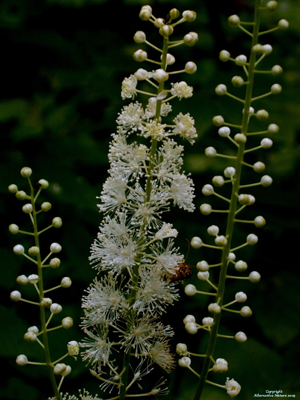Cimicifuga racemosa
| See Also | Botanical Monographs |
|---|
Black cohosh (Cimicifuga racemosa) is commonly thought of as herb for menopausal symptoms. To explore the characteristics, medicinal uses and prescribing considerations of this herb in more detail, check out the references indicated. [1] [2]
Contents
Characteristics
- Common Names: Black cohosh, Black snakeroot, Squawroot, Radix, Rafin, Bugbane, Rattleroot, Rattleweed, Actea racemosa (common name homeopathically), Macrotys acteoides
- Family: Ranunculaceae
- Habitat: Native to U.S.A. and Canada and is now cultivated in Europe. The species is considered "at risk".
- Parts Used: Roots and rhizomes, dried
- Constituents: Triterpene glycosides (active constituent), Isoflavones (formononetin, active constituent), aromatic acids, tannins, resin, fatty acids, starch, sugars, volatile oils
- Medicinal Actions: antitussive, nervine, uterine tonic, antispasmotic, alterative, emmenagogue, anti-inflammatory, antimalarial, antirheumatic, antispasmodic
Uses
Historical Uses:
Cimicifuga racemosa was used by North American Native people for menstrual pain, menopause, childbirth, rheumatism, headache, malaise, gynecopathy, kidney ailments, malaria, and sore throats. American colonists additionally used the herb for amenorrhea, uterine disorders, bronchitis, chorea, dropsy, fever, yellow fever, itch, lumbago, nervous disorders, and snakebite.
Medicinal Uses:
- Painful menses, delayed menses, ovarian cramps, cramping pain in uterus, and PMS
- Labor (to calm nervousness, relax muscles, and to normalize contractions)
- Menopause and post-surgical hormonal deficits (e.g., ovariectomy and hysterectomy)
- Other Conditions
- Rheumatic pain, rheumatoid arthritis (RA), osteoarthritis (OA), muscular and neurological pain, sciatica and neuralgia, heavy tensive pain
- Whooping cough and tinnitus
Prescribing Considerations
The information provided is intended to augment the treatment from a naturopathic doctor or other trained medical professional. Although most herbs are generally safe, it is recommended that you avoid self-prescribing especially when there is an underlying ongoing medical condition, if you are on any prescription medications or if you are pregnant or breastfeeding.
Formulations and Preparation
- Decoction - 1/2-1 tsp/cup decoction three times daily
- Tincture - 2-4mL (1:5, 60%) three times daily
- Dried root and rhizomes - 40-200mg
- Very effective for menopause if used for 2-6 months as alternative to HRT
Safety
The safety and prescribing considerations for Cimicifuga include:[3], [4]
- Generally regarded as safe.
- Side-effects are rare and limited to gastric upset. Historical evidence suggests throbbing headaches, nervous and cardiovascular depression can occur at high doses.
- Caution: in pregnancy during the first trimester due to its emmenagogue action (empirical) and lactation (toxic in large doses).
- Not be be used for more than 6 months without interruption
- Drug-Herb Interactions. [3]
- Androgen Blockage Chemotherapies, LHRH Antagonists, Antiandrogens - Prevention or reduction of drug adverse effects, potential or theoretical beneficial or supportive interaction with professional management; Cimicifuga reduces drug-induced vasomotor adverse effects (established effect in women but only anecdotal support for men).
- Hormone Replacement Therapy (HRT): Estrogen containing and Synthetic estrogen and Progesterone Analog Medications - Prevention or reduction of drug adverse effects, beneficial or supportive interaction with professional management; Cimicifuga supports reduced HRT doses, or tapered withdrawal by reducing symptoms associated with climacteric (menopause).
- Selective Estrogen Response Modulators (SERMs), Tamoxifen, Raloxifene - Prevention or reduction of drug adverse effects, beneficial or supportive interaction with professional management; Cimicifuga reduces drug-induced climacteric symptoms, may synergize with SERM anti-tumor effects in estrogen
receptor-positive cancer.
References
- ↑ Boon Heather, Smith Michael (2009) 55 Most Common Medicinal Herbs: The Complete Natural Medicine Guide Second Edition Institute of Naturopathic Education and Research, CCNM Toronto.
- ↑ Godfrey Anthony, Saunders Paul, Barlow Kerry, Gowan Matt (2011) Principles and Practices of Naturopathic Botanical Medicine, Advanced Botanical Medicine. V3 CCNM Press, Toronto.
- ↑ 3.0 3.1 Stargrove Mitchell Bebell, Treasure Jonathan, McKee Dwight L (2008) Herb, Nutrient and Drug Interactions: Clinical Implications and Therapeutic Strategies
- ↑ Brinker Francis (1997) Herbal Contraindications and Drug Interactions: Plus Herbal Adjuncts With Medicines, 4th Edition Eclectic Medical Publications.
